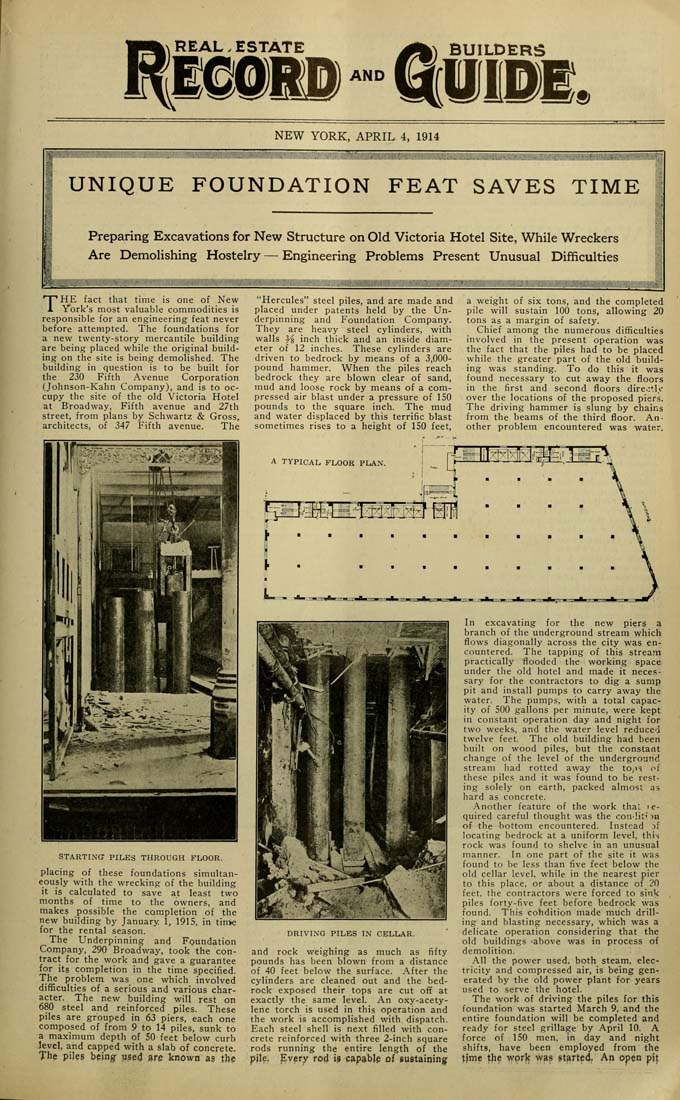Columbia University Libraries Digital Collections: The Real Estate Record
Use your browser's Print function to print these pages.
Real estate record and builders' guide: [v. 93, no. 2403: Articles]: April 4, 1914

Text version:
Please note: this text may be incomplete. For more information about this OCR, view About OCR text.
AND NEW YORK, APRIL 4, 1914 illliili:! MiiiiSi^^ UNIQUE FOUNDATION FEAT SAVES TIME Preparing Excavations for New Structure on Old Victoria Hotel Site, While Wreckers Are Demolishing Hostelry — Engineering Problems Present Unusual Difficulties ■■■■■■IIIIIIIW^^^^^^ ......Illlllllllllllllillllilllillllllllilllllllllllll^ .....llllilillliMilllililillllilliM^^^ ..........,: THE fact that time is one of New York's most valuable commodities is responsible for an engineering feat never before attempted. The foundations for a new twenty-story mercantile building are being placed while the original build¬ ing on the site is being demolished. The building in question is to be built for the 230 Fifth Avenue Corporation (Johnson-Kahn Company), and is to oc¬ cupy the site of the old 'Victoria Hotel at B'roadway, Fifth avenue and 27th street, from plans by Schwartz & Gross, architects, of 347 Fifth avenue. The ST.\RTI.\G PILES THROUGH FLOOR. placing of these foundations simultan¬ eously with the wrecking of the building it is calculated to save at least two months of time to the owners, and makes possible the completion of the new building by January 1, 1915, in tin>e for the rental season. The Underpinning and Foundation Company, 290 Broadway, took the con¬ tract for the work and gave a guarantee for its completion in the time specified. The problem was one which involved difficulties of a serious and various char¬ acter. The new building will rest on 680 steel and reinforced piles. These piles are grouped in 63 piers, each one composed of from 9 to 14 piles, sunk to a maximum depth of 50 feet below curb level, and capped with a slab of concrete. The piles being: use4 are known as the "Hercules" steel piles, and are made and placed under patents held by the Un¬ derpinning and Foundation Company. They are heavy steel cylinders, with walls f^ inch thick and an inside diam¬ eter of 12 inches. These cylinders are driven to bedrock by means of a 3,000- pound hammer. When the piles reach bedrock they are blown clear of sand, mud and loose rock by means of a com¬ pressed air blast under a pressure of 150 pounds to the square inch. The mud and water displaced by this terrific blast sometimes rises to a height of 150 feet, A TYPICAL FLOOR PLAN. a weight of six tons, and the completed pile will sustain 100 tons, allowing 20 tons as a margin of safety. Chief among the numerous difficulties involved in the present operation was the fact that the piles had to be placed while the greater part of the old build¬ ing was standing. To do this it was found necessary to cut away the floors in the first and second floors directly over the locations of the proposed piers. The driving hammer is slung by chains from the beams of the third floor. An¬ other problem encountered was water. DRIVING PILES IN CELLAR. and rock weighing as much as fifty pounds has been blown from a distance of 40 feet below the surface. After the cylinders are cleaned out and the bed¬ rock exposed their tops are cut off at exactly the same level. An oxy-acety- lene torch is used in this operation and the work is accomplished with dispatch. Each steel shell is next filled with con¬ crete reinforced with three 2-inch square rods running the entire length of the pile, pvery rod i? capable of sustaining In excavating for the new piers a branch of the underground stream which flows diagonally across the city was en¬ countered. The tapping of this stream practically flooded the working space under the old hotel and made it neces¬ sary for the contractors to dig a sump pit and install pumps to carry away the water. The pumps, with a total capac¬ ity of 500 gallons per minute, were kept in constant operation day and night for two weeks, and the water level reduced twelve feet. The old building had been built on wood piles, but the constant change of the level of the underground stream had rotted away the tO;)S of these piles and it was found to be rest¬ ing solely on earth, packed almost as hard as concrete. Another feature of the work that re¬ quired careful thought was the conliti in of the bottom encountered. Instead af locating bedrock at a uniform level, this rock was found to shelve in an unusual manner. In one part of the site it was found to be less than five feet below the old cellar level, while in the nearest pier to this place, or about a distance of 20 feet, the contractors were forced to sink piles forty-five feet before bedrock was found. This cohdition made much drill¬ ing and blasting necessary, which was a delicate operation considering that the old buildings -above was in process of demolition. All the power used, both steam, elec¬ tricity and compressed air, is being gen¬ erated by the old power plant for years used to serve the hotel. The work of driving the piles for this foundation was started March 9, and the entire foundation will be completed and ready for steel grillage by April 10. A force of ISO men, in day and night shifts, have been employed from the time tjie work was starte4. An open pit